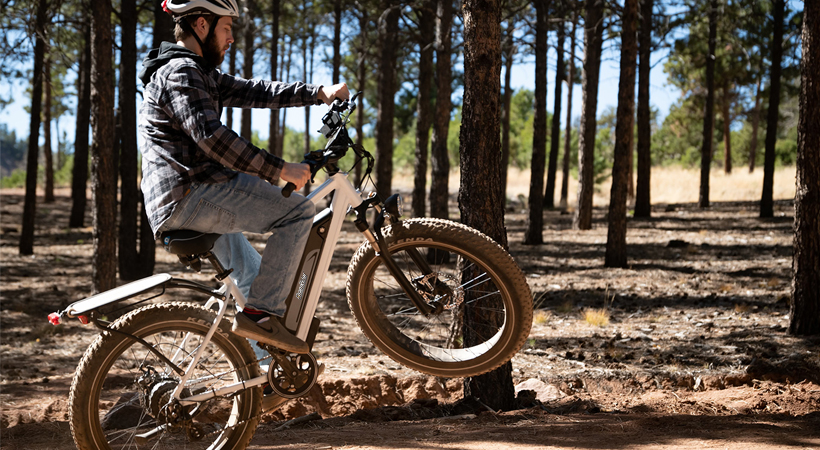Are you considering purchasing or assembling an electric bicycle but unsure about which battery type and size to choose? Selecting the right battery can have a significant impact on the performance, range, speed, and cost of an electric bicycle.
Here, we will explore different types of batteries suitable for electric bicycles and how to ensure you find the right one for your needs. By the end, you will have a clear understanding of the perfect battery for your electric bicycle. Let's get started.

How to Choose the Right Electric Bicycle Battery Type and Size
When selecting the appropriate battery type and size for your specific bicycle, several factors need to be considered, such as the intended use of the battery, how far you need to travel, and the terrain near your location.
Different bicycles require different battery types, capacities, and sizes. Most importantly, if your electric bicycle is intended for racing, commuting, or off-road use, you may have additional requirements.
Lastly, consider the climate conditions in which you will be cycling. For example, cold weather requires more power, necessitating a larger capacity battery to provide sufficient energy.
Before choosing an electric bicycle battery, it is essential to consider all relevant features. Let's take a look at what they are.

Factors to Consider When Choosing an Electric Bike Battery
Factors to Consider When Choosing an Electric Bike Battery
Range:
Most electric bikes are designed for daily commuting or leisurely rides, so having a battery that can cover the desired distance without frequent recharging is crucial. The range not only indicates the battery's lifespan but also its overall performance. High-end batteries with longer ranges can provide more power with less energy consumption, enhancing rider performance on hills and allowing them to go farther before needing a recharge. Keep the range in mind when selecting an electric bike battery to get the best value and experience from your electric bike.
Speed:
Speed capability should not be the primary factor in determining the most suitable electric bike battery for you. Most electric bikes are pedal-assisted, meaning they stop assisting once a certain speed is reached. Electric bikes are more about facilitating easy travel from point A to point B rather than delivering thrilling speed. While speed may be an appealing feature, ensuring your electric bike battery possesses all the qualities you need will guarantee long-term value and satisfaction.
Durability:
Batteries must withstand factors such as rain, snow, and extreme temperatures so that you can ride your bike safely year-round. Durability is especially important if you plan to use the electric bike off-road or in challenging terrains where it may endure impacts. To ensure maximum efficiency and lifespan, make sure the battery offers waterproof protection and an adequate temperature range. Investing in a durable electric bike battery will ultimately save you time and money in the long run.
Location:
Consider your residence and the terrain you will be riding on when selecting an electric bike battery. If you live near hilly areas, batteries designed for flat terrains may not be suitable. You will need a more powerful battery as attempting to climb steep terrain can significantly deplete your battery. Additionally, riders in warm climates should ensure their batteries can handle high temperatures, while those in colder regions need to be aware of the adverse effects cold weather can have on battery life and power output.
Charging Points:
If you plan to ride your electric bike regularly, it is crucial to ensure you have access to sufficient charging facilities on a regular basis. For example, consider whether you will be able to charge your electric bike while at work.
In addition, charging facilities may not always be available during your journey, so it is important to consider the availability of charging facilities when determining how far you can safely ride your electric bike away from home.
Ultimately, considering where you can charge the electric bike battery is crucial to ensuring your riding safety and enjoyment.
Weight:
The battery you choose for your electric-assist bike can be one of the most important decisions you make, and your weight plays a significant role in it.
To achieve optimal performance, you must consider how much power the battery needs to propel you up steep hills and on long rides. The heavier you are, the harder the electric bike needs to work. This can significantly reduce the advertised range.
Cost:
Choosing an electric bike battery based on your budget is an important consideration as it will determine the level of performance and features you can obtain. If you allocate too little funding for the battery, you may end up with lower-quality components that cannot provide a good range or performance.
On the other hand, bankrupting yourself for an overly powerful battery that doesn't meet your needs doesn't make sense.
It's important to research electric bike batteries and their prices carefully before deciding how much budget to allocate for the battery. Budgeting wisely will ensure you get the best electric bike experience without sacrificing other important needs in your life.
Volts, Amperes, and Watts
Understanding volts, amperes, and watts and their relationships can be helpful in determining the type of battery you need. Here, we'll provide a simplified explanation.
Volts – This unit of measurement represents voltage, but it can be thought of as speed. Higher voltage means a faster power supply. Low voltage is comparable to an older car driving on a highway, while high voltage is like a brand-new supercar.
Amperes – Amperes can be likened to the size of a highway. The more lanes there are, the more vehicles can travel. Low current indicates only a few vehicles passing through, while high current is akin to a massive multi-lane highway. Higher amperage allows for a greater amount of power to pass through.
Watts – Watts are the product of volts and amperes. A low-wattage system is like a single car driving on a road, while a high-wattage system is similar to 100 supercars driving on a highway.
Generally, high watts and high amperes are closely related. For instance, it wouldn't make sense to construct an enormous power highway for a group of slow-moving cars. However, there are variations to consider.
For example, a 48V battery may have a capacity of 13Ah or 20Ah. Ampere-hours (Ah) measure how many amperes can be supplied within one hour. A higher value indicates a greater power capacity.
We hope this provides you with a basic understanding of these terms when exploring different batteries. Next, we'll discuss selecting the appropriate voltage for a battery.

Which Voltage Should You Choose?
Understanding the ratings of volts, amperes, ampere-hours, watts-hours, and watts displayed on electric bicycles can be confusing. The most common (and often the first) number you'll encounter is volts. To simplify things, let's explore what you can expect from electric bicycles with different voltage options.
24V – This represents the lower end of battery ratings. Electric bicycles with this voltage typically have advertised ranges of approximately 15 miles.
36V – This is likely the most prevalent battery voltage level as it strikes a balance between power and affordability. Typically, advertised ranges for these bicycles range from 20 to 25 miles.
48V and 52V – These voltage levels generally offer ranges of around 30 to 35 miles on a single charge. They are considered high-end electric bicycles capable of delivering impressive power.
72V – Batteries of this size are uncommon in commercially available electric bicycles, but they can be easily obtained. The range you can expect with these batteries usually exceeds 40 miles.
It's important to note that the ranges mentioned here are rough estimates. Additionally, all these batteries can have different amperage ratings, which should also be taken into consideration, particularly if you require high power output for uphill riding.

Lead-acid, Nickel, or Lithium Batteries?
Choosing the type of battery to use on an electric bicycle can be a challenging decision. Each battery type has unique characteristics, and the choice should depend on your intended usage and the riding conditions you anticipate.
For example, if you frequently embark on long-distance journeys, Nickel Metal Hydride (NiMH) batteries are a good option due to their extended operating times. On the other hand, Lithium-ion (Li-ion) batteries are lighter, making them suitable for bicycles that need to tackle steep inclines.
Lead-acid batteries are inexpensive but heavy, which is why they are seldom used in modern electric bicycles. Regardless of your choice, consider the terrain you will be riding on, the distance you plan to cover, and your budget.
Final Thoughts
If you wish to select the ideal battery, it is beneficial to have some knowledge about voltage and current. This way, you can consider all the crucial factors when choosing a battery. We hope that you now possess all the necessary information for selecting the perfect electric bicycle battery. If you have any other inquiries or require additional assistance, please don't hesitate to ask. We wish you success in finding the electric bicycle battery that is perfect for you!




Comments (0)
There are no comments for this article. Be the first one to leave a message!